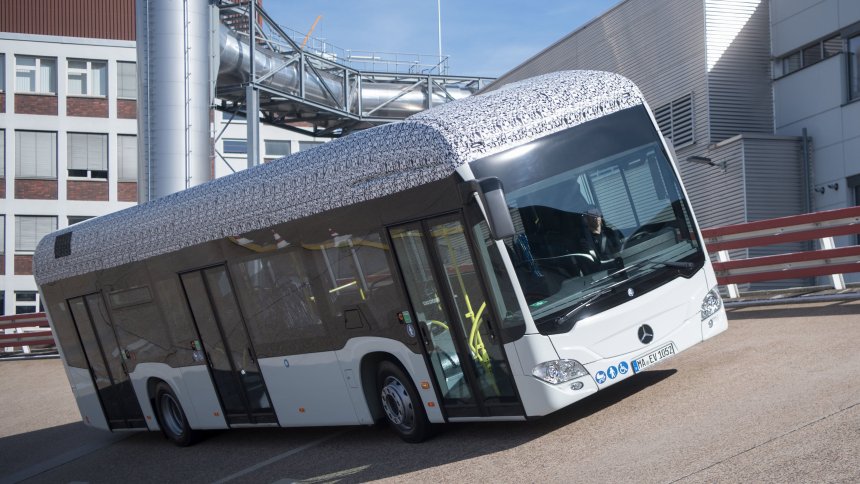Municipalities are fighting for climate-friendly public transport. But Daimler expressed skepticism in the presentation of an electric bus for local transport about its own product – and refers to an alternative.
Mercedes electric “Citaro”
Monday, 05.03.2018
20:19 clock
The car company Daimler ![]() is late with the introduction of electric buses. The Stuttgart company was also not impressed with the technology when it presented its first production-ready specimen. The company used the premiere to convince trade visitors of the benefits of other engines – such as diesel.
is late with the introduction of electric buses. The Stuttgart company was also not impressed with the technology when it presented its first production-ready specimen. The company used the premiere to convince trade visitors of the benefits of other engines – such as diesel.
“With Daimler Buses, the age of electromobility is now starting to take shape,” said the boss of the bus division, Hartmut Schick, criticizing the timetable. “We clearly set our priorities as follows: We put our electric bus on the road as quickly as possible, but we do not do it in a hurry, it needs to be mature and powerful.” End of 2018, the series production of the battery electric “Citaro E-Cell” should begin.
Such locally emission-free buses are considered in many ways in view of the exhaust gas scandal communities as a bearer of hope. While they have little influence on the cleanliness of cars in inner cities, many municipalities want to improve the air quality with modernized bus fleets. But unlike in China, where already hundreds of thousands of electric buses are traveling on the streets, established manufacturers in Europe are finding it difficult to manufacture such vehicles.
Range, costs, cold as counter arguments
The use is more complex than the city bus with internal combustion engine, said Gustav Tuschen, development manager of Daimlers Bussparte. “It is impossible to replace the combustion engine of today with an all-electric drive.” On the other hand, the costs and the limited range of e-buses, the complex power supply, as well as the workshop equipment, are currently being discussed. “E-mobility means thinking about public transport in a completely new way with buses and coaches.”
For transport companies, where this is too strenuous, Daimler also presented a possible alternative in the context of the e-bus concept: the diesel-Bus. “Every day, the Citaro and the CapaCity and Citaro hybrid […] large-capacity buses prove the state-of-the-art state of the art of internal combustion engine drives in use,” states the statement.
In fact, Daimler reclaims considerable development progress on the diesel. Compared to a city bus of emission standard Euro V, the nitrogen oxide emissions in the dieselHybrid “dropped by up to 98 percent, the particle emissions even reached the detection limit”. The emission of climate damaging carbon dioxide According to the information, however, it is only 20 percent lower.
Big cities demand emission-free buses
That Daimler participates in the race for the first large-scale electric bus for Europe at all and only slightly reluctantly is also due to political decisions in many cities. So want Hamburg and Berlin In just a few years, only buy emission-free buses. That’s why they have dozens of electric buses in 2017 advertised,
Berlin is rather dissatisfied with the response to the tender, which is why a delegation is now looking for alternatives in China. In Hamburg it seems to run better – the end of March to announce the Hochbahn according to its own information, who gets the contract for 60 vehicles.
The fact that Daimler qualifies does not seem to be a matter of course, according to today’s presentation. The Hamburger Hochbahn demands a minimum range of 150 kilometers with a battery charge. Of the batteryAccording to Daimler, however, Mercedes can achieve this only in summer, since energy consumption in the winter rises sharply as a result of heating.
Remedy could create with “fuel”, so possibly diesel, operated auxiliary heating, so Daimler. A Hochbahn spokesman did not want to tell manager-magazin.de whether Daimler is still in the race in the face of such restrictions.
In the interests of many public transport companies, Daimler wants to advise municipalities on the development of timetables, cycle times and operational plans, energy management and the charging infrastructure. “If a public transport company wants to electrify its fleet completely, it is a complicated intervention in all operations and takes several years,” said Schick.
For the further prospects of his new e-bus, he was reserved. After the start of the series you will see how the demand for the all-electric “Citaro” is developing. “Depending on that, we will then start production.”

